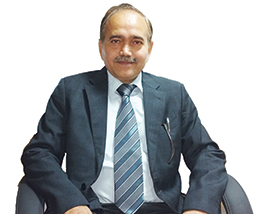

CIO
Rajiv Gandhi Cancer Institute & Research Centre, New Delhi
Transforming Medical Infrastructure
Initially in hospitals the Electronic Data Processing (EDP) was a small department located in a corner of the basement mostly into billing and printing of typed reports. Later a few forms of modules like lab and radiology reporting workflow, integration of Lab Analysers with HIS, and appointment booking came into being. Now almost all major hospitals have HIS system to manage workflow of patients, employees, material, lab and radiology, revenue and expense accounting, billing etc. Electronic Health Record System (EHR) has helped the patient within a hospital by automating workflows. Picture Archival & Communication System (PACS) helps the patients and doctors by storing images (X-Ray, CT, MRI etc.) in digital form. Patient portal, mHealth, real time management dashboards, clinical decision support system with evidence based medicine are some of the buzzwords for past couple of years.

Leveraging Technology
Rajiv Gandhi Cancer Institute & Research Centre has used IT extensively to improve outcome, affordability and patient experience – the three facets of healthcare delivery. We have a robust IT infrastructure and our servers are virtualised and scalable. We have built adequate network security using firewall and have implemented strict IT security policy. WiFi facilitates our doctors and nurses to use IT systems on the move. Doctors have been equipped with iPADs and can see patient records while on rounds. Our OTs is connected with patient record system and PACS. The surgeons can refer to X-Ray, CT, MRI etc. or check treatment history, allergies, prior surgeries and any other details online during surgery. The clinicians and IT team are working hand in hand to scale up healthcare delivery capabilities.
Shift in Perception

There is dramatic change in perception over the years. Acceptance came in non-medical areas first. Hospital operations are now managed using IT application in all medium and large hospitals. The problem is not of acceptance but more of meeting expectations. The application service providers have to rise up to user expectations. On the clinical applications side, the picture is interesting. As management issues mandate for going paperless, there comes strong resistance, partly due to demand on clinicians time in making data entry and rest due to general inertia for any change. Shortcomings of the IT systems are also responsible for this resistance. Most of these systems are designed keeping western conditions in mind. Patients per doctor are many more here.
Innovating Technology
IT adoption significantly reduces the chances of manual errors during diagnosis and treatment. The online billing and lab sample with barcodes ensure there are no manual errors. PACS (integrated with HIS) enables dynamic modality work lists and thus automatically schedules all the investigations in order of billing. Patient vitals (temperature, BP, Pulse Rate etc.) could be captured automatically using bluetooth enabled devices integrated with EHR. Although IT helps the operations, it does not save manpower, but it improves the quality of the output that human resources produce. Patient portal enables the patients access to the reports at home reducing the hospital visits. All these improve affordability of the treatment.
Be a part of Elets Collaborative Initiatives. Join Us for Upcoming Events and explore business opportunities. Like us on Facebook , connect with us on LinkedIn and follow us on Twitter , Instagram.












